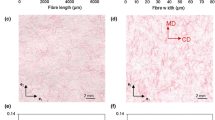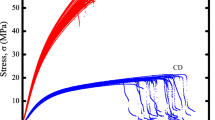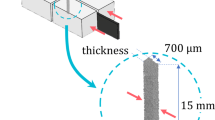Abstract
Fine prediction of the elastic properties of paper materials can now be obtained using sophisticated fibre scale numerical approaches. However, there is still a need, in particular for low-density papers, for simple and compact analytical models that enable the elastic properties of these papers to be estimated from the knowledge of various structural information about their fibres and their fibrous networks. For that purpose, we pursued the analysis carried out in Marulier et al. (Cellulose 22:1517–1539, 2015. https://doi.org/10.1007/s10570-015-0610-6) with low-density papers that were fabricated with planar random and orientated fibrous microstructures and different fibre contents. The fibrous microstructures of these papers were imaged using X-ray synchrotron microtomography. The corresponding 3D images revealed highly connected fibrous networks with small fibre bond areas. Furthermore, the evolutions of their Young’s moduli were non-linear and evolved as power-laws with the fibre content. Current analytical models of the literature do not capture these trends. In light of these experimental data, we developed a fibre network model for the in-plane elasticity of papers in which the main deformation mechanisms of the micromechanical model is the shear of the numerous fibre bonds and their vicinity, whereas the fibre parts far from these zones were considered as rigid bodies. The stiffness tensor of papers was then estimated both numerically using a discrete element code and analytically using additional assumptions. Both approaches nicely fit the experimental trends by adjusting a unique unknown micromechanical parameter, which is the shear stiffness of bonding zones. The estimate of this parameter is relevant in light of several recently reported experimental results.









Similar content being viewed by others
Data availability
Yes.
Code availability (software application or custom code)
Not applicable.
References
Advani SG, Tucker CL (1987) The use of tensors to describe and predict fiber orientation in short fiber composites. J Rheol 31:751–784. https://doi.org/10.1122/1.549945
Alava M, Niskanen K (2006) The physics of paper. Rep Prog Phys 69:669–723. https://doi.org/10.1088/0034-4885/69/3/R03
Antoine C, Nygård P, Gregersen ØW et al (2002) 3D images of paper obtained by phase-contrast X-ray microtomography: image quality and binarisation. Nucl Instrum Methods Phys Res Sect Accel Spectrometers Detect Assoc Equip 490:392–402. https://doi.org/10.1016/S0168-9002(02)01003-3
Åström JA, Mäkinen JP, Alava MJ, Timonen J (2000) Elasticity of Poissonian fiber networks. Phys Rev E 61:5550–5556. https://doi.org/10.1103/PhysRevE.61.5550
Bensoussan A, Lions J-L, Papanicolau G (1978) Asymptotic analysis for periodic structures. North Holland, Amsterdam
Borodulina S (2016) Extracting fiber and network connectivity data using microtomography images of paper. Nord Pulp Pap Res J 31:469–478
Borodulina S, Motamedian HR, Kulachenko A (2018) Effect of fiber and bond strength variations on the tensile stiffness and strength of fiber networks. Int J Solids Struct 154:19–32. https://doi.org/10.1016/j.ijsolstr.2016.12.013
Brandberg A, Kulachenko A (2017) The effect of geometry changes on the mechanical stiffness of fibre-fibre bonds. In: Advances in pulp and paper research. Manchester, pp 683–719. https://doi.org/10.15376/frc.2017.2.683
Brandberg A, Kulachenko A (2020) Compression failure in dense non-woven fiber networks. Cellulose 27:6065–6082. https://doi.org/10.1007/s10570-020-03153-2
Cox HL (1952) The elasticity and strength of paper and other fibrous materials. Br J Appl Phys 3:72–79. https://doi.org/10.1088/0508-3443/3/3/302
DeMaio A, Patterson T (2008) Similarities in bonding influence between pre-failure tensile creep and stress–strain behavior of paper. Mech Mater 40:133–149. https://doi.org/10.1016/j.mechmat.2007.06.007
DeMaio A, Lowe R, Patterson T, Ragauskas A (2006) Direct observations of bonding influence on the tensile creep behavior of paper. Nord Pulp Pap Res J 21:297–302. https://doi.org/10.3183/npprj-2006-21-03-p297-302
Dumont PJJ, Le Corre S, Orgéas L, Favier D (2009) A numerical analysis of the evolution of bundle orientation in concentrated fibre-bundle suspensions. J Non-Newton Fluid Mech 160:76–92. https://doi.org/10.1016/j.jnnfm.2009.03.001
Eder M, Terziev N, Daniel G, Burgert I (2008) The effect of (induced) dislocations on the tensile properties of individual Norway spruce fibres. Holzforschung 62:77–81. https://doi.org/10.1515/HF.2008.011
Fischer WJ, Hirn U, Bauer W, Schennach R (2012) Testing of individual fiber-fiber joints under biaxial load and simultaneous analysis of deformation. Nord Pulp Pap Res J 27:237–244. https://doi.org/10.3183/npprj-2012-27-02-p237-244
Godinho PMJS, Jajcinovic M, Wagner L et al (2019) A continuum micromechanics approach to the elasticity and strength of planar fiber networks: theory and application to paper sheets. Eur J Mech A Solids 75:516–531. https://doi.org/10.1016/j.euromechsol.2018.10.005
Gregersen O, Houen PJ, Helle T et al (2001) Three-dimensional lmaging of paper by use of synchrotron X-ray microtomography. J Pulp Pap Sci 27:50–53
Guiraud O, Orgéas L, Dumont PJJ, Rolland du Roscoat S (2012) Microstructure and deformation micromechanisms of concentrated fiber bundle suspensions: an analysis combining X-ray microtomography and pull-out tests. J Rheol 56:593–623. https://doi.org/10.1122/1.3698185
Heyden S, Gustafsson P-J (1998) Simulation of fracture in a cellulose fibre network. J Pulp Pap Sci 24:160–165
Heyden S (2000) Network modelling for the evaluation of mechanical properties of cellulose fibre fluff. PhD Thesis, Lund University
Hirn U, Schennach R (2015) Comprehensive analysis of individual pulp fiber bonds quantifies the mechanisms of fiber bonding in paper. Sci Rep 5:10503. https://doi.org/10.1038/srep10503
Jabbour L, Bongiovanni R, Chaussy D et al (2013) Cellulose-based Li-ion batteries: a review. Cellulose 20:1523–1545. https://doi.org/10.1007/s10570-013-9973-8
Jajcinovic M, Fischer WJ, Hirn U, Bauer W (2016) Strength of individual hardwood fibres and fibre to fibre joints. Cellulose 23:2049–2060. https://doi.org/10.1007/s10570-016-0895-0
Kappel L, Hirn U, Bauer W, Schennach R (2009) A novel method for the determination of bonded area of individual fiber-fiber bonds. Nordic Pulp and Paper Res J 24(199):205
Krasnoshlyk V, Rolland du Roscoat S, Dumont PJJ et al (2018) Three-dimensional visualization and quantification of the fracture mechanisms in sparse fibre networks using multiscale X-ray microtomography. Proc R Soc Math Phys Eng Sci 474:20180175. https://doi.org/10.1098/rspa.2018.0175
Kulachenko A, Uesaka T (2012) Direct simulations of fiber network deformation and failure. Mech Mater 51:1–14
Kulachenko A, Denoyelle T, Galland S, Lindström SB (2012) Elastic properties of cellulose nanopaper. Cellulose 19:793–807. https://doi.org/10.1007/s10570-012-9685-5
Le Corre S, Caillerie D, Orgéas L, Favier D (2004) Behavior of a net of fibers linked by viscous interactions: theory and mechanical properties. J Mech Phys Solids 52:395–421. https://doi.org/10.1016/S0022-5096(03)00090-5
Le Corre S, Dumont P, Orgéas L, Favier D (2005) Rheology of highly concentrated planar fiber suspensions. J Rheol 49:1029–1058. https://doi.org/10.1122/1.1993594
Macfarlane AL, Kadla JF, Kerekes RJ (2012) High performance air filters produced from freeze-dried fibrillated wood pulp: fiber network compression due to the freezing process. Ind Eng Chem Res 51:10702–10711. https://doi.org/10.1021/ie301340q
Magnusson MS (2016) Investigation of interfibre joint failure and how to tailor their properties for paper strength. Nord Pulp Pap Res J 31:109–122. https://doi.org/10.3183/npprj-2016-31-01-p109-122
Mansour R, Kulachenko A, Chen W, Olsson M (2019) Stochastic constitutive model of isotropic thin fiber networks based on stochastic volume elements. Materials 12:538. https://doi.org/10.3390/ma12030538
Martoïa F, Dumont PJJ, Orgéas L et al (2016a) On the origins of the elasticity of cellulose nanofiber nanocomposites and nanopapers: a micromechanical approach. RSC Adv 6:47258–47271. https://doi.org/10.1039/C6RA07176G
Martoïa F, Dumont PJJ, Orgéas L et al (2016b) Micro-mechanics of electrostatically stabilized suspensions of cellulose nanofibrils under steady state shear flow. Soft Matter 12:1721–1735. https://doi.org/10.1039/C5SM02310F
Martoïa F, Orgéas L, Dumont PJJ et al (2017) Crumpled paper sheets: low-cost biobased cellular materials for structural applications. Mater Des 136:150–164. https://doi.org/10.1016/j.matdes.2017.09.031
Marulier C, Dumont PJJ, Orgéas L et al (2012) Towards 3D analysis of pulp fibre networks at the fibre and bond levels. Nord Pulp Pap Res J 27:245
Marulier C, Dumont PJJ, Orgéas L et al (2015) 3D analysis of paper microstructures at the scale of fibres and bonds. Cellulose 22:1517–1539. https://doi.org/10.1007/s10570-015-0610-6
Motamedian HR, Kulachenko A (2019) Simulating the hygroexpansion of paper using a 3D beam network model and concurrent multiscale approach. Int J Solids Struct 161:23–41. https://doi.org/10.1016/j.ijsolstr.2018.11.006
Motamedian HR, Halilovic AE, Kulachenko A (2019) Mechanisms of strength and stiffness improvement of paper after PFI refining with a focus on the effect of fines. Cellulose 26:4099–4124. https://doi.org/10.1007/s10570-019-02349-5
Nanko H, Ohsawa (1989) Mechanisms of fibre bond formation. Fundam. Papermak. Trans IXth Fund Res Symp Camb., pp 783–830
Neagu RC, Gamstedt EK, Berthold F (2006) Stiffness contribution of various wood fibers to composite materials. J Compos Mater 40:663. https://doi.org/10.1177/0021998305055276
Niskanen K (2011) Mechanics of paper products. Walter de Gruyter, Berlin
Niskanen K, Krenlampi P (1998) In-plane tensile properties. In: Papermaking science and technology, paper physics, Fapet Oy, Helsinki
Nyholm K, Ander P, Bardage S, Geoffrey D (2001) Dislocations in pulp fibres-their origin, characteristics and importance—a review. Nord Pulp Pap Res J 16:376–384. https://doi.org/10.3183/npprj-2001-16-04-p376-384
Oyola-Reynoso S, Heim AP, Halbertsma-Black J et al (2015) Draw your assay: fabrication of low-cost paper-based diagnostic and multi-well test zones by drawing on a paper. Talanta 144:289–293. https://doi.org/10.1016/j.talanta.2015.06.018
Page DH, Seth RS (1980) The elastic modulus of paper. II: The importance of fiber modulus, bonding, and fiber length. Tappi 63:113–116
Page DH, Tydeman PA, Hunt M (1962) A study of fibre-to-fibre bonding by direct observation. Form Struct Pap 1:171–194
Page DH, Seth RS, DeGrace JH (1979) The elastic modulus of paper—the controlling mechanisms. Tappi 62:99–102
Park NA, Ko YC, Melani L, Kim HJ (2020) Mechanical properties of low-density paper. Nordic Pulp Paper Res J 35(1):61–70. https://doi.org/10.1515/npprj-2019-0052
Räisänen VI, Alava MJ, Niskanen KJ, Nieminen RM (1997) Does the shear-lag model apply to random fiber networks? J Mater Res 12:2725–2732. https://doi.org/10.1557/JMR.1997.0363
Rigdahl M, Andersson H, Westerlind B, Hollmark H (1983) Elastic behaviour of low density paper described by network mechanics. Fibre Sci Technol 19:127
Rolland du Roscoat S, Bloch J-F, Thibault X (2005) Synchrotron radiation microtomography applied to investigation of paper. J Phys D: Appl Phys 38(10A):A78–A84. https://doi.org/10.1088/0022-3727/38/10A/015
Rolland du Roscoat S, Decain M, Thibault X et al (2007) Estimation of microstructural properties from synchrotron X-ray microtomography and determination of the REV in paper materials. Acta Mater 55:2841–2850. https://doi.org/10.1016/j.actamat.2006.11.050
Salmen L, Fellers C (1989) The nature of volume hydroexpansivity of paper. Nat Vol Hydroexpansivity Pap 15:J63–J65
Sampson WW (2004) A model for fibre contact in planar random fibre networks. J Mater Sci 39:2775–2781. https://doi.org/10.1023/B:JMSC.0000021453.00080.5a
Sampson WW (2008) Modelling stochastic fibrous materials with mathematica®. Springer, New York
Sanchez-Palencia E (1980) Non-homogeneous media and vibration theory. Lecture notes in physics. Springer, Berlin
Schmied FJ, Teichert C, Kappel L et al (2012) Joint strength measurements of individual fiber–fiber bonds: an atomic force microscopy based method. Rev Sci Instrum 83:073902
Schmied FJ, Teichert C, Kappel L et al (2013) What holds paper together: nanometre scale exploration of bonding between paper fibres. Sci Rep 3:2432. https://doi.org/10.1038/srep02432
Schulgasser K (1981) On the in-plane elastic constants of paper. Fibre Sci Technol 15:257–270. https://doi.org/10.1016/0015-0568(81)90051-8
Schulgasser K, Page DH (1988) The influence of tranverse fibre properties on the in-plane elastic behaviour of paper. Compos Sci Technol 32:279–292
Simon J-W (2020) A review of recent trends and challenges in computational modeling of paper and paperboard at different scales. Arch Comput Methods Eng. https://doi.org/10.1007/s11831-020-09460-y
Toll S (1993) Note: on the tube model for fiber suspensions. J Rheol 37:123–125. https://doi.org/10.1122/1.550460
Tollenaere H, Caillerie D (1998) Continuous modeling of lattice structures by homogenization. Adv Eng Softw 29:699–705. https://doi.org/10.1016/S0965-9978(98)00034-9
Twede D, Selke SE, Kamdem D-P, Shires D (2014) Cartons, crates and corrugated board: handbook of paper and wood packaging technology. DEStech Publications, Inc
Vassal J-P, Orgéas L, Favier D et al (2008) Upscaling the diffusion equations in particulate media made of highly conductive particles. II. Application to fibrous materials. Phys Rev E 77:011303. https://doi.org/10.1103/PhysRevE.77.011303
Viguié J, Dumont PJJ, Orgéas L et al (2011) Surface stress and strain fields on compressed panels of corrugated board boxes. an experimental analysis by using digital image stereocorrelation. Compos Struct 93:2861–2873. https://doi.org/10.1016/j.compstruct.2011.05.018
Viguié J, Latil P, Orgéas L et al (2013) Finding fibres and their contacts within 3D images of disordered fibrous media. Compos Sci Technol 89:202–210. https://doi.org/10.1016/j.compscitech.2013.09.023
Wernersson EL, Borgefors G, Borodulina S, Kulachenko A (2014) Characterisations of fibre networks in paper using micro computed tomography images. Nord Pulp Pap Res J 29:468–475
Wu X-F, Dzenis YA (2005) Elasticity of planar fiber networks. J Appl Phys 98:093501. https://doi.org/10.1063/1.2123369
Acknowledgments
The 3SR Lab and the LGP2 are part of the LabEx Tec 21 (Investissements d’Avenir: grant agreement no. ANR-11-LABX-0030) and the PolyNat Carnot Institute (Investissements d’Avenir: grant agreement no. ANR16-CARN-0025-01).
Funding
C.M wish to thank Univ. Grenoble Alpes for its PhD research grant. No other financial support was received for the submitted work.
Author information
Authors and Affiliations
Corresponding author
Ethics declarations
Conflict of interest
The authors declare they have no conflict of interest.
Human and animals rights
The authors declare that the submitted work involved no Human Participant and Animals.
Consent
All the authors consent and are informed that this work is submitted in the journal Cellulose.
Originality
The authors declare that this work is original and has not been submitted as a research paper in antoher journal.
Additional information
Publisher's Note
Springer Nature remains neutral with regard to jurisdictional claims in published maps and institutional affiliations.
Supplementary Information
Below is the link to the electronic supplementary material.
Appendices
Appendix 1
In the theory developed by Cox, the Young’s modulus \({E}_{Cox}\) of planar random fibre networks is:
where \({E}_{f}\) is the Young’s modulus of the fibres.
In the approach developed by Page and Seth, the Young’s modulus \({E}_{PS}\) of planar random fibre networks is:
where \({G}_{f}\) is the shear modulus of fibres, \({r}_{1} =\overline{l}/\overline{w }\) is the fibre slenderness and RBA is the relative bonded area that can be measured using various experimental techniques or estimated analytically using the Sampson’s model as follows:
where \(\overline{c }=\overline{w }G/\delta\) and \(\delta =1.5\times {10}^{-4}\) g m−1.
In the 2D network model proposed by Wu and Dzenis, the effective Young’s modulus \({E}_{WD}\) and the Poisson ratio \({\nu }_{WD}\) of planar random fibre network are written as a function of the dimensionless fibre density \(q\) (for cylindrical fibres of mean diameter \(\overline{w }\), \(n=4\phi {r}_{1}/\pi\) is the number of fibre per unit of volume) as follows:
and
where \({\nu }_{f}\) is the Poisson ratio of the fibres, \({n}_{c}\) is a percolation threshold beyond which fibres form fully connected planar networks without disjointed substructures (for planar networks with random orientations, some numerical studies showed that \({n}_{c}\approx 5.7\) (Åström et al. 2000; Alava and Niskanen 2006)), and \(a\) and \(b\) are dimensionless numbers that are expressed as a function of both the coordination number \(\overline{z }\) and a critical fibre segment length \({l}_{c}\approx \overline{w }/2\sqrt{6(1+{\nu }_{f})}\) as follows:
and
Appendix 2
Accounting for all the assumptions stated in “Theoretical upscaling” section, the macroscale stress tensor \({\varvec{\upsigma}}\) Eq. (11) can be expressed as follows:
where
By assuming that fibre bonds are uniformly distributed along the fibre length, the following discrete sums can be written (Vassal et al. 2008):
Then, by assuming that \({\text{s}}_{i}\) and \({\text{s}}_{j}\) are uncorrelated, the expressions of \({\mathbb{B}}_{1}\) and \({\mathbb{B}}_{2}\) are
where \({\mathbb{A}}\) is the fourth-order rod orientation tensor defined in Eq. (22). These two relations were validated using the microstructure generator and yielded to the analytical estimates proposed in Eqs. (21) and (23).
Rights and permissions
About this article
Cite this article
Orgéas, L., Dumont, P.J.J., Martoïa, F. et al. On the role of fibre bonds on the elasticity of low-density papers: a micro-mechanical approach. Cellulose 28, 9919–9941 (2021). https://doi.org/10.1007/s10570-021-04098-w
Received:
Accepted:
Published:
Issue Date:
DOI: https://doi.org/10.1007/s10570-021-04098-w




